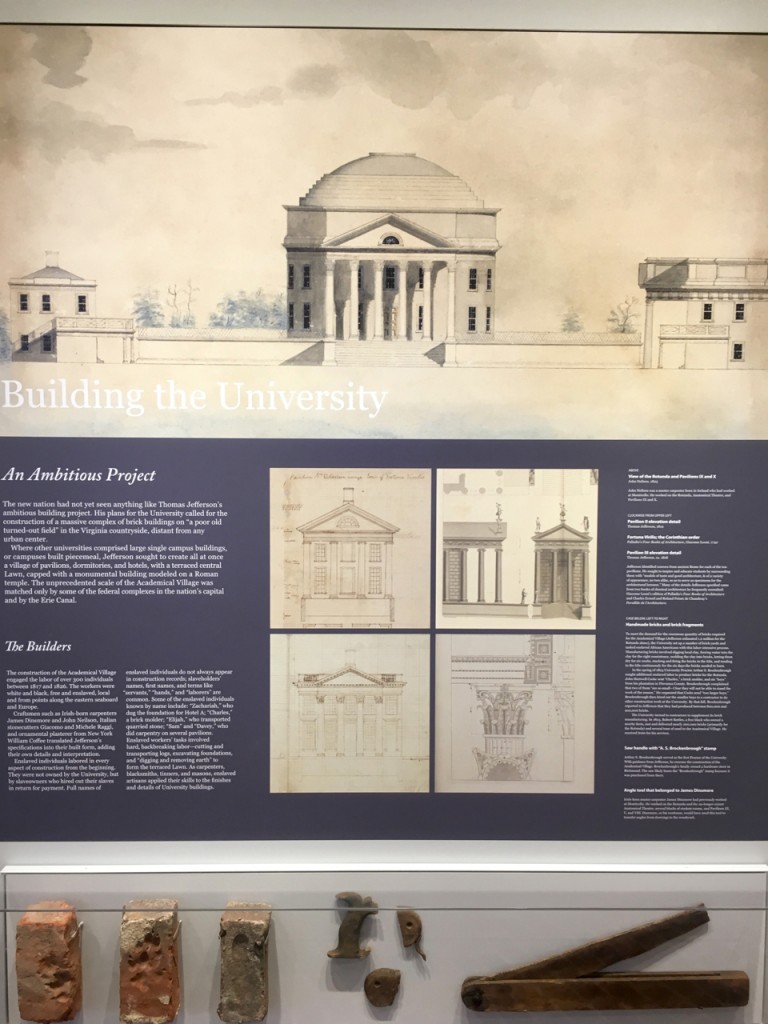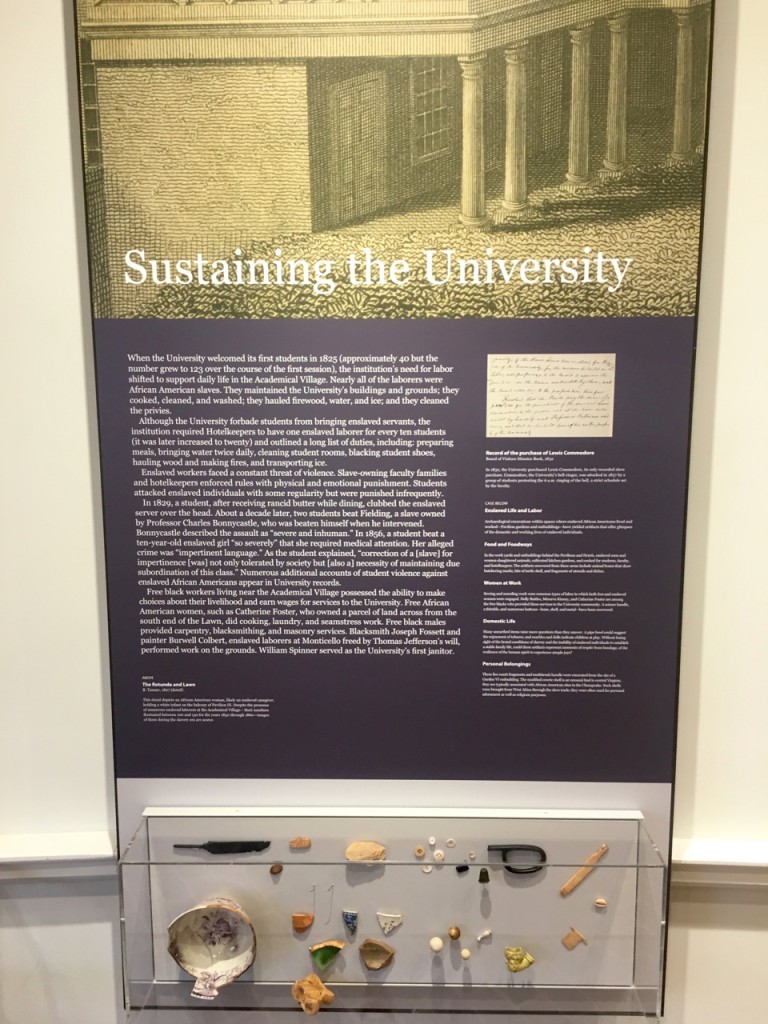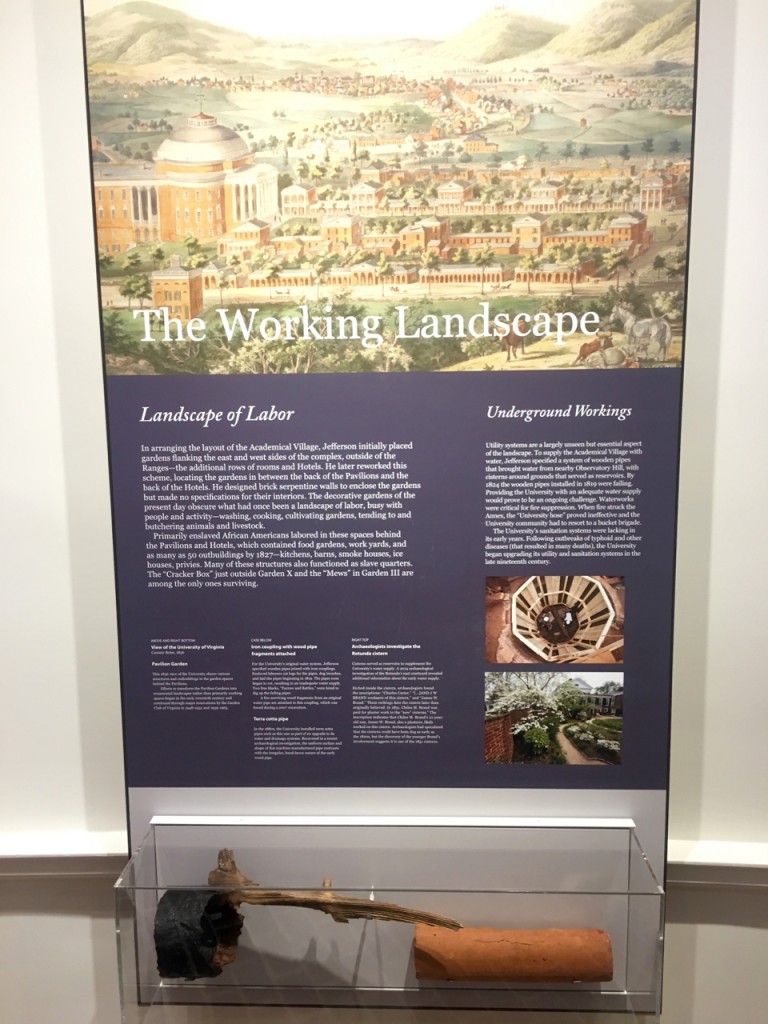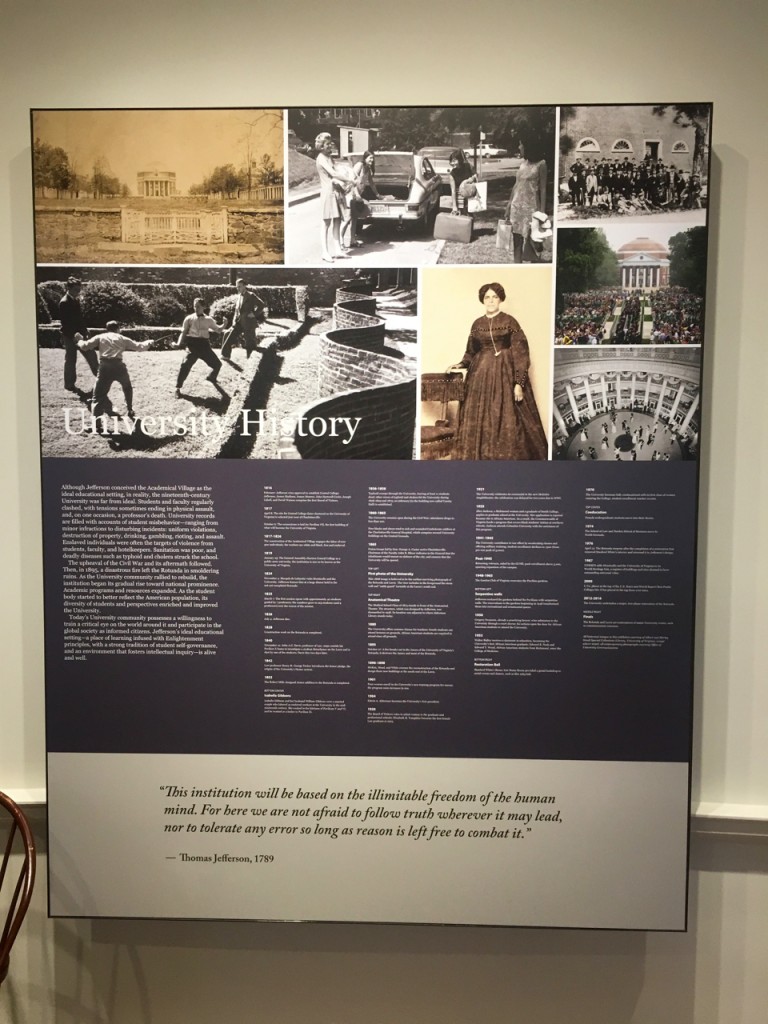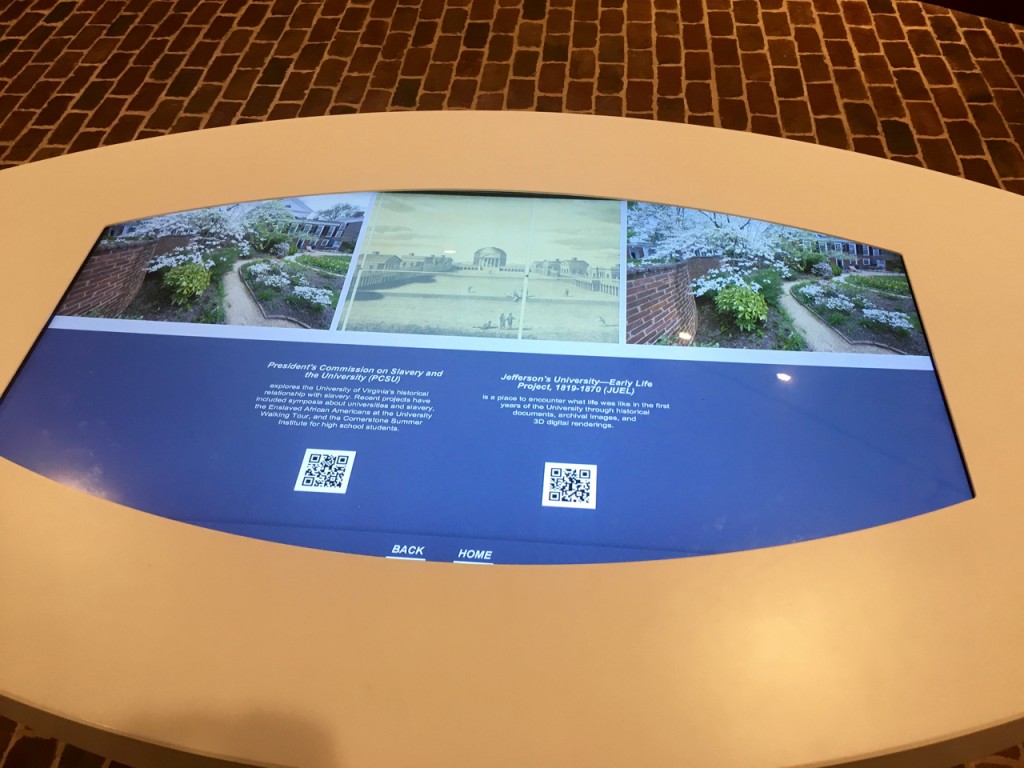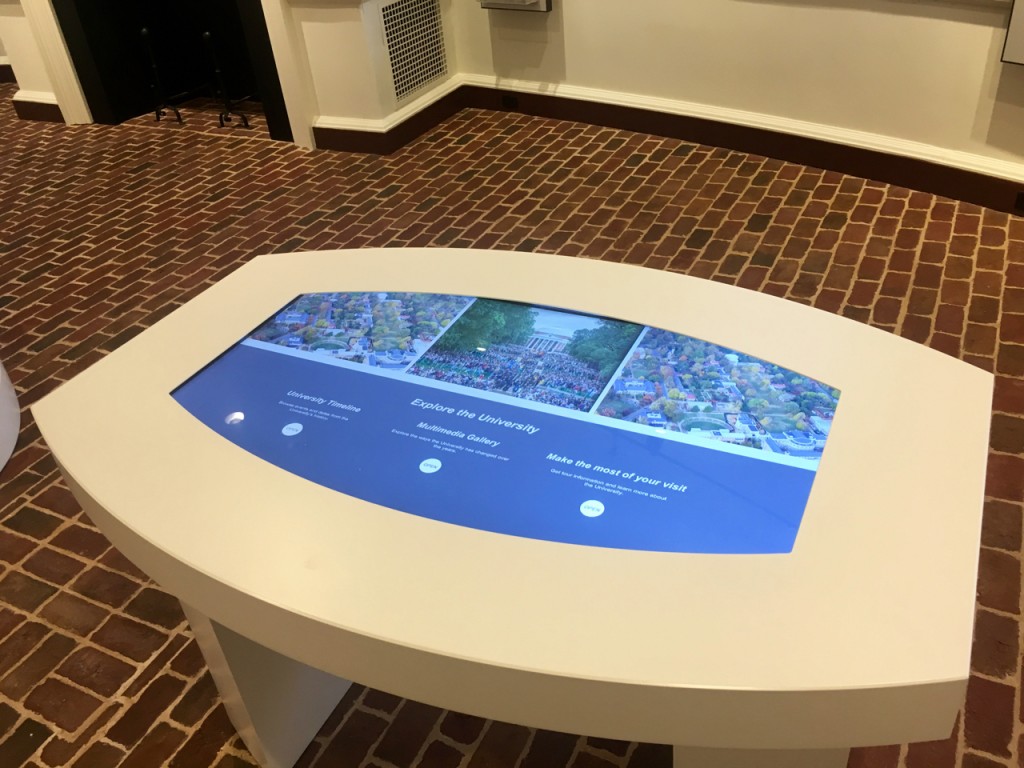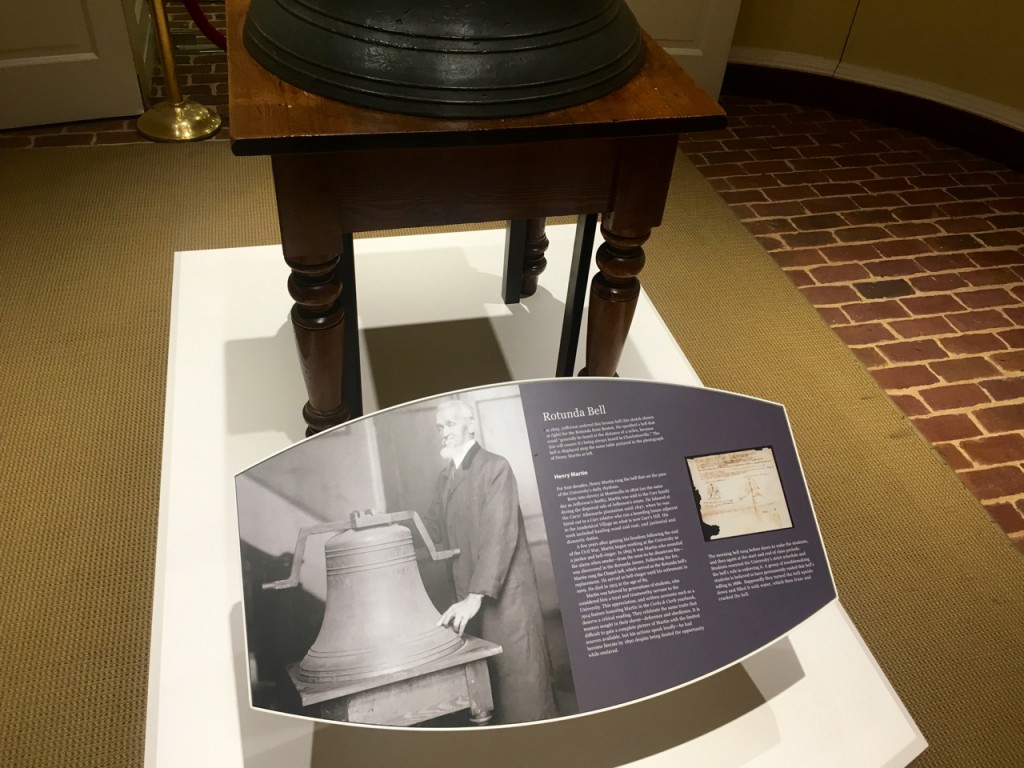Rotunda Renovations Complete–New Visitor’s Center Now Open.
This fall (2016), the Rotunda renovations were completed after significant work on the building over the past two years. The building reopened earlier in the semester and it has been returned in some important ways to the original concept–there are more classrooms and student access to the building–it is once again a living part of the University. The President’s Commission on Slavery and the University is proud to have participated in designing the brand new Rotunda Visitor’s Center (in the Lower East Oval Room). We worked with the Office of the Architect and the outside designer, Riggs Ward, on the content of the intepretive wall panels that now line the room. Our signal contribution, of course, was to include where relevant details about slavery and the lives of the enslaved at the University. We are thrilled with the results and honored to have been a part of creating a new history of the Academical Village.
The Visitor’s Center contains nine interpretive wall panels, several of which discuss slavery at the University. The first such panel, “Building the University,” includes enslaved African Americans in its discussion of the builders (photo below).
The panel text reads:
“The construction of the Academical Village engaged the labor of over 300 individuals between 1817 and 1826. The workers were white and black, free and enslaved, local and from points along the eastern seaboard and Europe.
Craftsmen such as Irish-born carpenters James Dinsmore and John Neilson, Italian stonecutters Giacomo and Michele Raggi, and ornamental plaster from New York William Coffee translated Jefferson’s specifications into their built form, adding their own details and interpretation.
Enslaved individuals labored in every aspect of construction from the beginning. They were not owned by the University, but by slaveowners who hired out their slaves in return for payment. Full names of enslaved individuals do not always appear in construction records; slaveholders’ names, first names, and terms like “servants,” “hands,” and “laborers” are common. Some of the enslaved individuals known by name include: “Zachariah,” who dug the foundation for Hotel A; “Charles,” a brick molder; “Elijah,” who transported quarried stone; “Sam” and “Davey,” who did carpentry on several pavilions. Enslaved workers’ tasks involved hard, backbreaking labor—cutting and transporting logs, creating foundations, and “digging and removing earth” to form the terraced Lawn. As carpenters, blacksmiths, tinners, and masons, enslaved artisans applied their skills to the finishes and details of the University buildings.”
The next panel, “Sustaining the University,” focuses intently on the lives of African Americans–both enslaved and free–at the University from its opening in 1825 until the end of slavery in 1865 (photo below).
The text of the “Sustaining the University” panel reads:
“When the University welcomed its first students in 1825 (approximately 40 but the number grew to 123 over the course of the first session), the institution’s need for labor shifted to support daily life in the Academical Village. Nearly all of the laborers were African American slaves. They maintained the University’s buildings and grounds; they cooked, cleaned, and washed; they hauled firewood, water, and ice; and they cleaned the privies.
Although the University forbade students from bringing enslaved servants, the institution required hotelkeepers to have one enslaved laborer for every ten students (it was later increased to twenty) and outlined a long list of duties, including: preparing meals, bringing water twice daily, cleaning student rooms, blacking student shoes, hauling wood and making fires, and transporting ice.
Enslaved workers faced a constant threat of violence. Slave-owning faculty families and hotelkeepers enforced rules with physical and emotional punishment. Students attacked enslaved individuals with some regularity but were punished infrequently.
In 1829, a student, after receiving rancid butter while dining, clubbed the enslaved server over the head. About a decade later, two students beat Fielding, a slave owned by Professor Charles Bonnycastle, who was beaten himself when he intervened. Bonnycastle described the assault as “severe and inhuman.” In 1856, a student beat a ten-year-old slave girl “so severely” that she required medical attention. He alleged crime was “impertinent language.” As the student explained, “correction of a [slave] for impertinence [was] not only tolerated by society but [also a] necessity of maintaining due subordination of this class.” Numerous additional accounts of student violence against enslaved African Americans appear in University records.
Free black workers living near the Academical Village possessed the ability to make choices about their livelihood and earn wages for services to the University. Free African American women, such as Catherine Foster, who owned a parcel of land across from the south end of the Lawn, did cooking, laundry, and seamstress work. Free black males provided carpentry, blacksmithing, and masonry services. Blacksmith Joseph Fossett and painter Burwell Colbert, enslaved laborers at Monticello freed by Thomas Jefferson’s will, performed work on the grounds. William Spinner served as the University’s first janitor.”
Another panel (visible between the two windows to the left of the fireplace in the panorama above and pictured below) examines the “Working Landscape” at the University.
This panel focuses on the landscape of labor at the early University. The text for the panel, as well as the descriptive text for the water pipe fragment in the case at the bottom of the panel, reads:
“In arranging the layout of the Academical Village, Jefferson initially placed gardens flanking the east and west sides of the complex, outside of the Ranges—the additional rows of rooms and hotels. He later reworked this scheme, locating the gardens in between the back of the Pavilions and the back of the Hotels. He designed brick serpentine walls to enclose the gardens but made no specifications for their interiors. The decorative gardens of the present day obscure what had once been a landscape of labor, busy with people and activity—washing, cooking, cultivating gardens, tending to and butchering animals and livestock.
Primarily enslaved African Americans labored in these spaces behind the Pavilions and Hotels, which contained food gardens, work yards, and as many as 50 outbuildings by 1827—kitchens, barns, smokehouses, ice houses, privies. Many of these structures also functioned as slave quarters. The “Cracker Box” just outside Garden X and the “Mews” in Garden III are among the only ones surviving.
CASE BELOW—Iron coupling with wood pipe fragments attached. For the University’s original water system, Jefferson specified wooden pipes joined with iron couplings. Enslaved laborers cut logs for the pipes, dug trenches, and laid the pipes beginning in 1819. The pipes soon began to rot, resulting in an inadequate water supply. Two free blacks, “Farrow and Battles,” were hired to dig up the failing pipes. A few surviving wood fragments from an original water pipe are attached to this coupling, which was found during a 2007 excavation.”
Another panel (below), discussing the recently discovered and now uncovered chemical hearth (far left of panorama picture), does not discuss slavery, but we do know that the University rented annually an enslaved person to work as the attendant to the chemical laboratory, cleaning up after classes, maintaining the hearth, and for a time before 1830, possibly living in a small Rotunda room nearby.
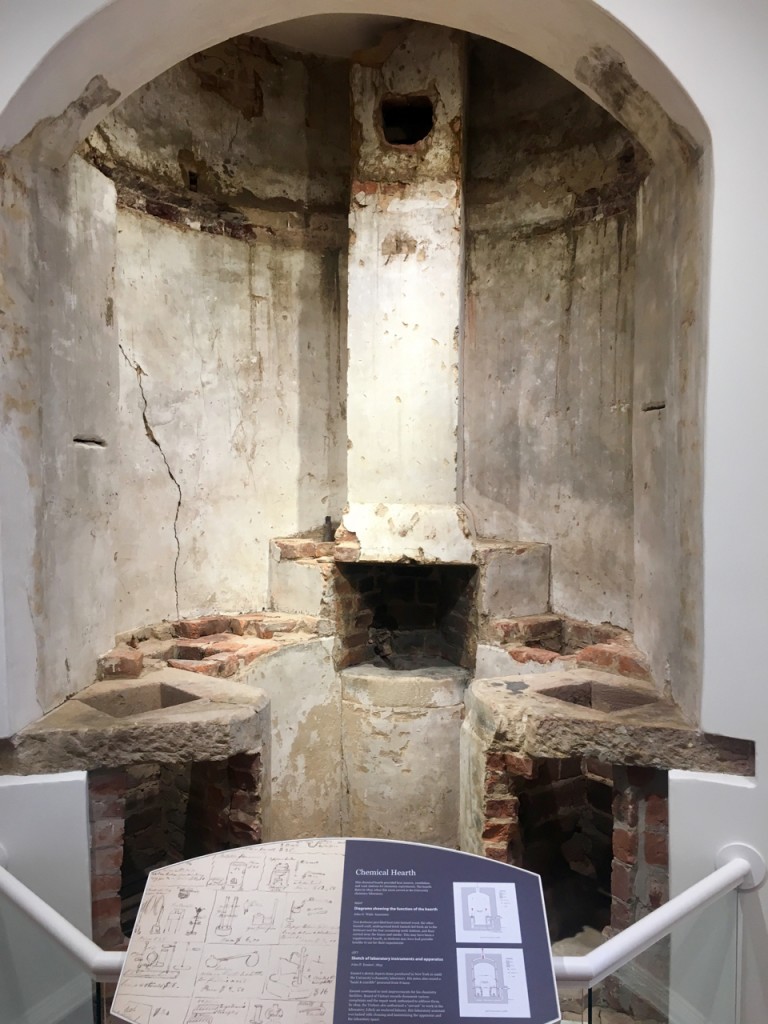 One last panel focuses on the long arc of “University History,” and includes a photograph of Isabella Gibbons. The panel also has a timeline that includes details about African Americans at UVA.
One last panel focuses on the long arc of “University History,” and includes a photograph of Isabella Gibbons. The panel also has a timeline that includes details about African Americans at UVA.
The main exhibit space for the Visitor’s Center in the Lower East Oval Room also has two touch screen interactive kiosks that visitors can use to learn more about the early history of the University—these, too, offer even greater detail about slavery and the enslaved—with links to the commission website, to the Jefferson’s University—The Early Life Project, to a detailed complete University timeline, and even a multimedia gallery.
Outside the Visitor’s Center in the main hallway, there is one last exhibit, visible upon entering the building, that reminds visitors of the important roles the enslaved (and later freedpeople) played in building, maintaining, and sustaining the University. This exhibit showcases the old University bell, installed in the Rotunda in the 1820s as part of an effort to ensure that students would actually get up and go to class. The original bell was rung at dawn by an enslaved person. In 1868, former slave Henry Martin was hired to be the bell-ringer (picture below).
The main text of the Rotunda Bell panel focuses on Henry Martin and reads:
“For four decades, Henry Martin rang the bell that set the pace of the University’s daily rhythm.
In 1825, Jefferson ordered the bronze bell for the Rotunda from Boston. He specified that a bell that could “generally be heard at the distance of 2 miles, because this will ensure that it’s always being heard in Charlottesville.” Martin, born into slavery at Monticello in 1826 (on the same day as Jefferson’s death), Martin was sold to the Carr family during the dispersal sale of Jefferson’s estate. He labored at the Carr’s Albemarle plantation (Bentivar) until 1847, when he was hired out to a Carr relative who ran a boarding house adjacent to the Academical Village on what is now Carr’s Hill. His work included hauling wood and coal, and janitorial and domestic duties.
A few years after gaining his freedom following the end of the Civil War, Martin began working at the University as a janitor and bell-ringter. In 1895 it was Martin who sounded the alarm when smoke—from the soon-to-be disastrous fire—was discovered in the Rotunda Annex. Following the fire, Martin rang the Chapel bell, which served as the Rotunda bell’s replacement. He served as bell-ringer until his retirement in 1909. He died in 1915 at the age of 89.
Martin was beloved by generations of students, who considered him a loyal and trustworthy servant to the University. This appreciation, and written accounts such as a 1914 feature honoring Martin in the Corks & Curls yearbook, deserve a critical reading. They celebrate the same traits that masters sought in their slaves—deference and obedience. It is difficult to gain a complete picture of Martin with the limited sources available, but his actions speak loudly—he had become literate by 1890 despite being denied the opportunity while enslaved.”
The Commission has worked tirelessly over the past three years both to highlight existing plaques, memorials, and structures that speak directly to the life and labor of enslaved African Americans at the University prior to 1865 as part of an effort to reinscribe the history of slavery back on to the University landscape and to tell some of the life stories of the enslaved people who toiled here. This new Rotunda Visitor’s Center will likely be the first stop for many people visiting the University. The inclusion of so many details about the history of slavery here represents an important step in the process the PCSU hopes to achieve. Our Enslaved African Americans Walking Tour map is also available, and we hope this encourages visitors to explore both the old Academical Village and many stops beyond (the Henry Martin plaque, the site of the Anatomical Theater, Gibbons House, the African American cemetery, The Piedmont Plantation enslaved gravesite at Gooch-Dillard, the Catherine Foster site).
-Kirt von Daacke



